It is not so hard to grow new grass. Instead, it is easy. But if you plan to cultivate a new lawn, you must put some effort into your new growing lawn.
Growing includes certain essential stages, and the grasses have various parts in their body. Special care should be taken of the roots.
Because the more profound the roots, the more the output will be sound.
Lawn care takes effort, but nobody can stop you from having an excellent green, lush lawn if you can perform all the tasks correctly.
This article will tell you the perfect use of fertilizers, the correct time to use fertilizers on new grass, and many more.
Understanding how and when to fertilize the grass seeds is the most important thing apart from everything.
The Reason Behind Fertilizing New Grass

Providing the correct amount of nutrient content to the new grass is very important, or else how will your lawn look healthy and green?
Fertilizers can improve your soil’s health, ensuring healthy new grasses on your lawn. Potassium, phosphorus, and nitrogen are the primary nutrients present in the fertilizer.
The soil that does not have the nutrients mentioned above and the new grasses above will be facing difficulty soon, lacking growth.
Also, adding too much fertilizer or using the wrong fertilizers might lead to the new grasses burning.
Types of Fertilizer for New Grass
There are two different and main types of fertilizers found in the local markets or online sites to start with –
- Regular fertilizer (slow)
- Starter fertilizer (quick)
Consider the new grasses to be like the new-born infants. Lawns are almost like human beings. If you want beauty, you need to maintain certain things.
Who does not desire to have thick green lawns? The infants have got a lot of difference in their food diet, the new grasses also have got different fertilizers than that of the others – the big plants.
Weed and feed fertilizers are the best fertilizers for preventing weeds from germinating.
It is an essential fertilizer, and whoever plans to prepare a healthy lawn, keep this fertilizer in mind.
- Specially designed to be used when planting new grass, Scotts Turf Builder Starter Food for New...
- This ready-to-spray liquid starter fertilizer makes it easy to feed and water your grass at the same...
- Apply this fertilizer anytime you're planting new grass, whether it's starting a new lawn, reseeding...
- This lawn care product is safe to use on any grass type
- Grows new grass 70% thicker, 35% quicker versus unfed grass
- Improves seeding results--also great for sod and grass plugs
- 24-25-4 fertilizer ratio provides the nutrients for developing lawns
- Safe for any grass type, whether you're planting new grass, starting a new lawn, or reseeding an...
But when planting the new grass seeds, avoid this fertilizer because it prevents them from germinating.
Crabgrass is also one of the best fertilizers to be used when you are seeding your lawn.
This fertilizer does not prevent the grass seeds from germinating; it also blocks the weeds from germinating for at least six weeks.
The Three Main Nutrients of The Fertiliser
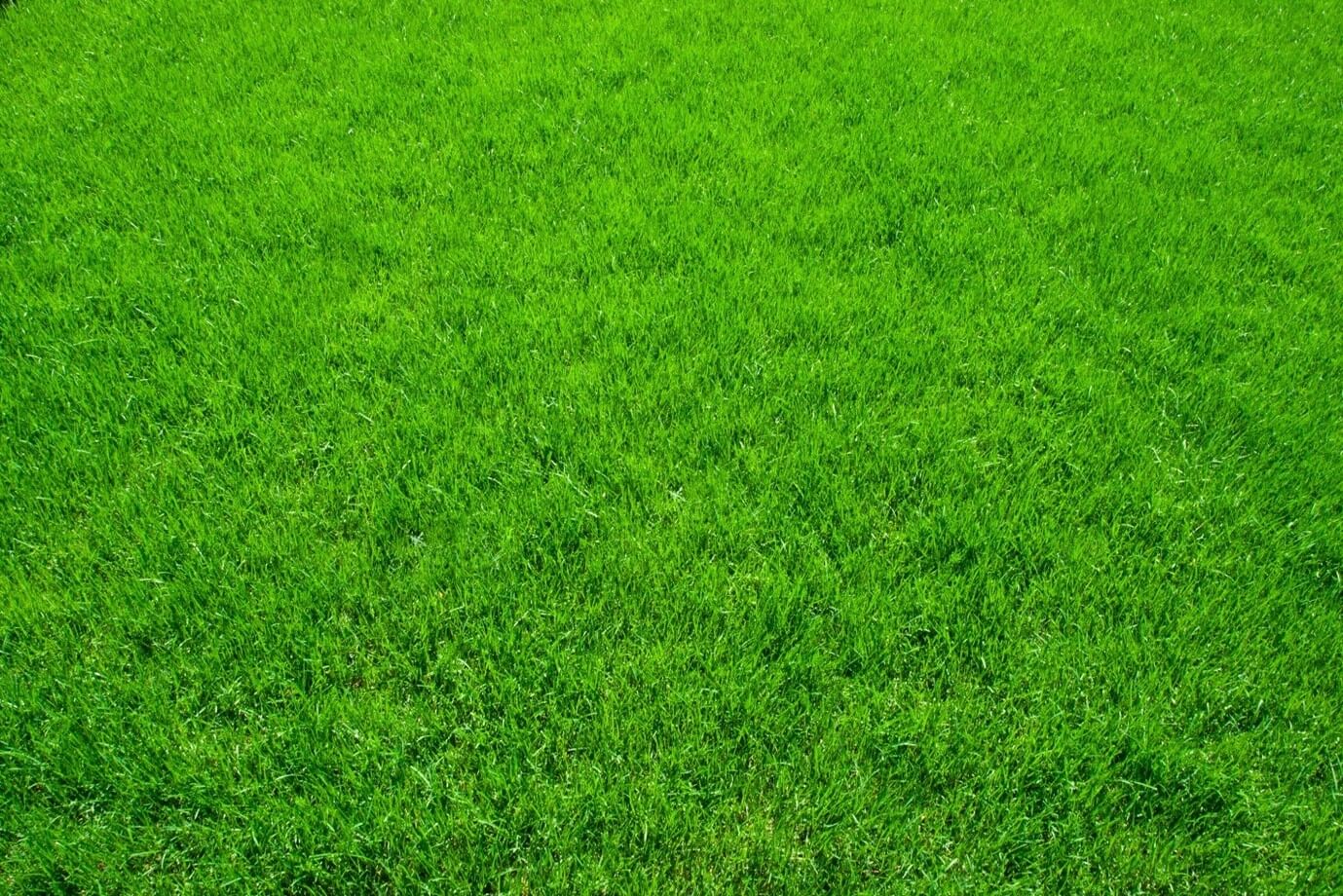
Nitrogen, phosphorus, and potassium are the three primary nutrients required in fertilizer for growing new grass.
- Nitrogen: helps the new grasses enhance their green color more.
- Phosphorus: helps to grow the roots of the new grasses well.
- Potassium: helps you protect the new grasses from diseases.
Each fertilizer has its ratio for these nutrients mentioned above. The numbers on the fertilizer pack indicate the nutrient content.
Soil tests always help you determine which fertilizer you should buy and which nutrients will be appropriate for your soil to grow new grass.
Maintaining your lawn’s health is very important, or you will never be able to view a beautiful green lawn. Ensure you buy a pH kit before growing the new grass on your lawn.
The Process of Adding Fertiliser to New Grass
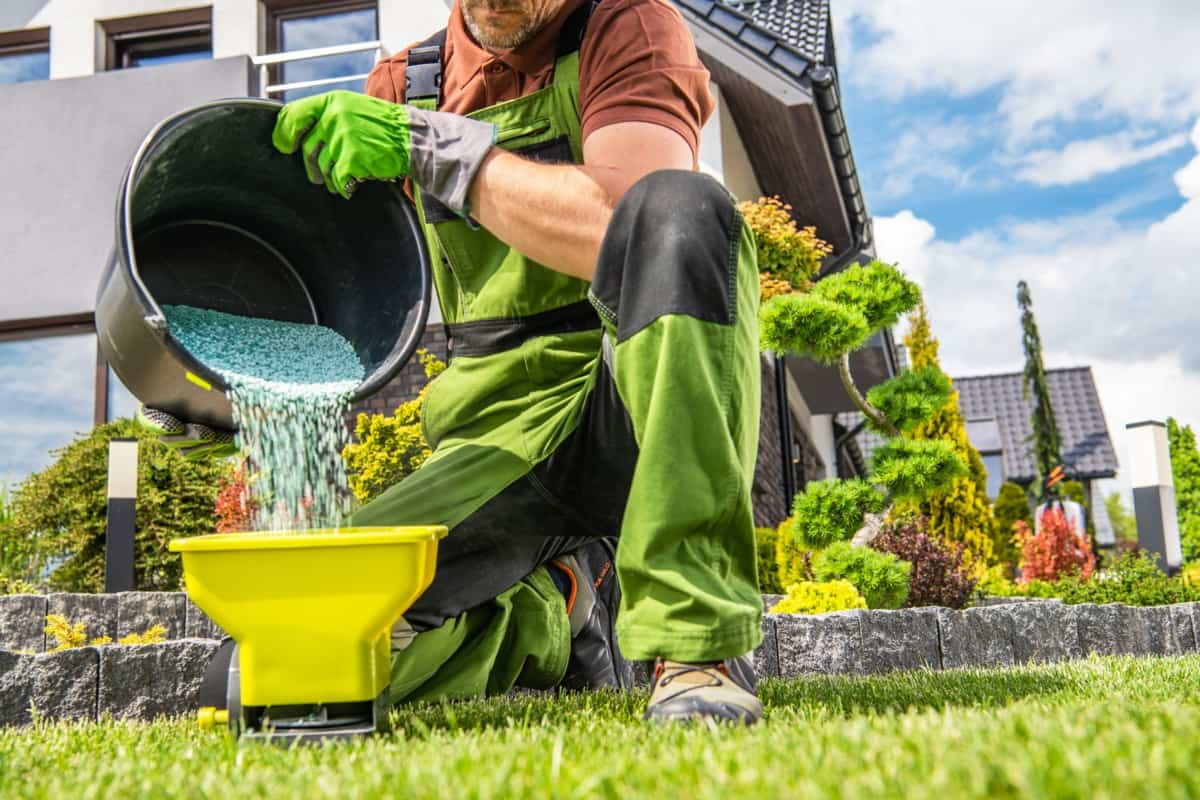
- Remove the dead grasses from your lawn. Repairing lawns is complex. Most people want fresh lawns.
- Apply the starter fertilizer evenly around your lawn or the area you chose for seeding.
- Apply the grass seeds properly upon it.
- Apply a bit of compost over the seedings. This will help to retain the moisture in the new grass seeds.
- Water regularly to keep the seedlings moist. Watering will help the seeds to germinate. Do water lightly twice a day until and unless the seedlings properly grow.
- After a bit of establishment, more care is to be taken of the new grass seeds.
- Apply the regular fertilizer, rich in nitrogen content, after establishing the grass seeds or after six to eight weeks of seeding.
- Mow the new grass every day. This ensures the good health of your lawn before fertilizing. Now, your lawn 1 to 2 days beforehand for better results.
Factors to Consider Before Fertilising New Grass
1. Poor Soil
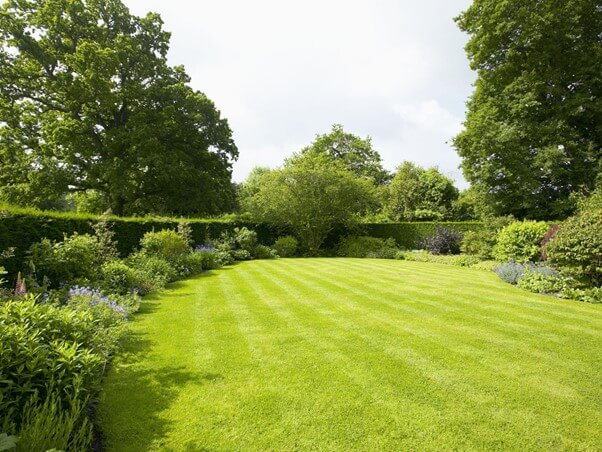
What do you understand by poor soil? Poor soil means insects, weeds, and yards filled with fungus with a high chance of diseases, eroded soil, and patchy leftover grasses.
In a poor lawn or poor soil, you will be able to find all these qualities.
These are very harmful to growing plants, and not only new glass and other plants might get harmed by the atmosphere if not fed with the proper amount of nutrients.
2. The Correct Ratio
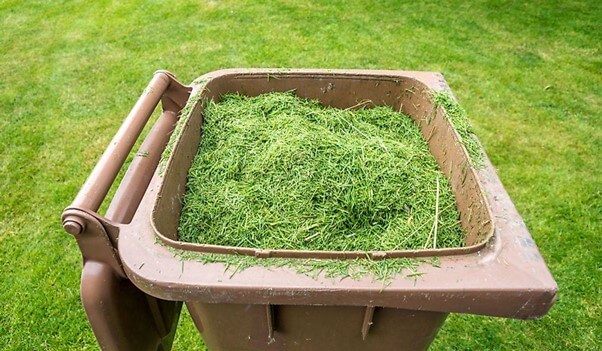
The nitrogen content should always be high among all the other nutrients present in fertilizer for growing new grass.
The lawns, which are already grassy, do not need much phosphorus or potassium.
So always look for fertilizers where the content of nutrients, like the amount of nitrogen, should be the highest, with the other two having smaller quantities.
If your lawn is established but you want more greenery in it, you can follow the tip mentioned above.
3. Timing
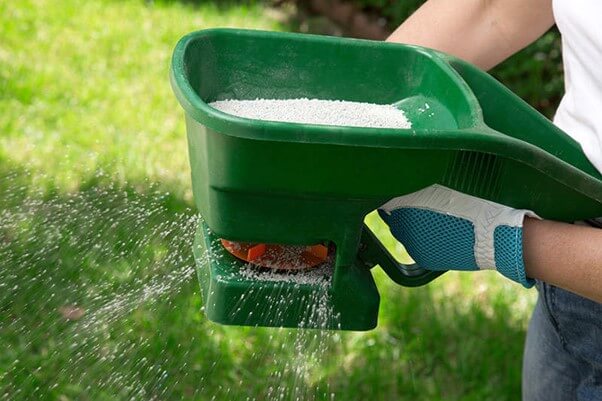
Before growing new grass, ensure your lawn’s soil is ready to intake the grass seeds.
What is to be done after preparing the soil for the grass seeds?
The last step is to fertilize the lawn with a starter fertilizer only if your lawn is empty.
Add the fertilizer before spreading the seeds, or you may do it later.
For spreading the seeds, you may use this –
- Mini broadcast spreader: Scotts Turf Builder EdgeGuard Mini Broadcast Spreader can be used to apply...
- Usage: Lawn spreader comes pre-calibrated and fully assembled, with a fold-down handle for easy...
- EdgeGuard technology: EdgeGuard technology keeps lawn product off landscaping, driveways, and...
- Operation: Mini spreader features redesigned hopper and agitator for smoother product funneling,...
But it is better to apply before seeding. It is the best time to fertilize one’s lawn. Never reapply fertilizers.
In case the ratio goes wrong, your established grasses might get burnt.
If you cannot view growth, never get eager to fertilize the lawn to encourage faster growth.
Fertilizing too many times might be very harmful to the established or the new grasses.
Always wait around four to eight weeks to reapply your fertilizer on the lawn.
- Early Spring: February, March, and April are when seeds germinate.
- Late Spring: April, May, and June are when weeds gear up. When these weeds are young, during this time, they claim to be very active and efficient.
- Summer: June, July, and August are the hottest months. This is the perfect time to keep your lawn beautiful. Sun is the most incredible food of all, and during this summer season, the lawns gain essential nutrients from the Sun directly. This helps them to have lush and thick new green grasses.
- Late Summer: August, September, and October are when winter slowly begins, and the new grass growth begins to slow down. Again, during this time, the weeds plan to get active.
4. Composting

Fertilizers are full of various sorts of chemicals. But composting is a method of fertilizing that is within our grip. Apply a thin layer of compost on your lawn every two years.
Applying it every 3 or 4 years ensures your compost is dark and rich. This helps to increase the nutrient content in your soil.
You can make compost by yourself by decomposing materials or collect it from your local and nearest composting center. Plant nurseries are present everywhere.
So, if you are unable to find a local composting center, do contact these nurseries to collect some compost amount.
You can also distribute the compost among your friends or neighbors if you have a small lawn.
Conclusion
Use starter fertilizers for empty lawns and regular fertilizers for established lawns. Regular ones are too good to boost the growth of your lawn.
It has got a slow effect. Do not use the fertilizers frequently.
It might bring more significant problems to your beautiful lawn. Adding fertilizers is not the only thing to do; a good seedbed is equally essential.
If your soil is not fertile, you will never receive good results if the seedlings are not spread evenly.
Before the winter begins, use the fertilizer. This ensures fast growth during the spring season.
This spring season is the time to get started, providing all the most significant opportunities. You can also use heavy phosphorus fertilizers for good root growth.




